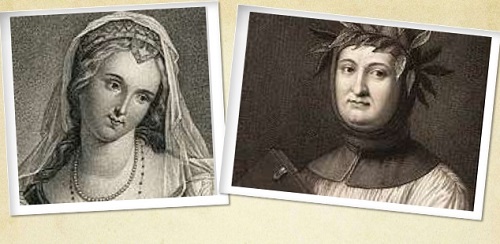Prompt: Petrarch, Laura and the Sonnets
On an April day in 1327, Italian poet Francesco Petrarch first saw �Laura,� She would become his muse for more than 300 sonnets.
It was Good Friday and he saw her at St. Clare Church in Avignon. There is some controversy about the identity of Laura, but it is generaly thought that she was a real woman. Many sources identify her as Laura de Noves, a married woman and mother. Whether she knew that she was his muse, and whether or not Petrarch ever contacted her is not known. Laura de Noves died during the Black Death plague of 1348.
The first 263 poems Petrarch wrote for her while she was alive and he called them Rime in Vita Laura. After she died, the poems he wrote were known as Rime in Morte Laura.
His love for Laura was unconsummated. Petrarch wrote about this love:
�In my younger days, I struggled constantly with an overwhelming but pure love affair � my only one, and I would have struggled with it longer had not premature death, bitter but salutary for me, extinguished the cooling flames. I certainly wish I could say that I have always been entirely free from desires of the flesh, but I would be lying if I did.�Lord Byron wrote this sarcastic couplet about Petrarch's love-at-a-distance for Laura:
Think you, if Laura had been Petrarch's wife
He would have written sonnets all his life?
Petrarch's poems popularized the Italian sonnet form and influenced the English sonnets that came in the Elizabethan era. Petrarch did not invent the sonnet. It had been a popular classical form long before him. "Sonnet" comes from the Italian sonetto, which means �a little sound or song."
Traditionally, the sonnet is a fourteen-line poem written in iambic pentameter, which uses a particular rhyme scheme and has a structured thematic organization.
The sonnet form popularized by Petrarch and which now carries his name uses two stanzas. One is an octave (8 lines) with the rhyme scheme abbaabba and the second a sestet (6 lines) with either a cdecde or cdcdcd rhyme scheme.
Some of Petrarch's sonnets were translated by Chaucer and other poets, but their Middle English is still difficult for modern readers. But you can find a Petrarchan sonnet that was written in 1903 and is engraved on a plaque found on the lower level of the Statue of Liberty. That sonnet is 'The New Colossus' by Emma Lazarus.
'Not like the brazen giant of Greek fame,
With conquering limbs astride from land to land;
Here at our sea-washed, sunset gates shall stand
A mighty woman with a torch, whose flame
Is the imprisoned lightning, and her name
Mother of Exiles. From her beacon-hand
Glows world-wide welcome; her mild eyes command
The air-bridged harbor that twin cities frame.
'Keep, ancient lands, your storied pomp!' cries she
With silent lips. 'Give me your tired, your poor,
Your huddled masses yearning to breathe free,
The wretched refuse of your teeming shore.
Send these, the homeless, tempest-tost to me,
I lift my lamp beside the golden door!'
A variation of that form is known as the Shakespearean, or English sonnet, This sonnet form uses iambic pentameter and has three quatrains (4 lines) and a couplet follow this rhyme scheme: abab, cdcd, efef, gg.
Traditionally, the first stanza of a sonnet is the question and the break is seen as a "turn" with the second stanza being an answer or response. In the English sonnet the concluding couplet is a conclusion, amplification, or even refutation of the previous three stanzas,
And there are many variations on these two formal definitions.
John Milton�s sonnets blended the two variations and didn't follow all the rules. (See his "When I Consider How My Light is Spent")
The Spenserian sonnet, named for the sixteenth century English poet Edmund Spenser, uses the Shakespearean three quatrains and a couplet but uses �couplet links� between quatrains (rhyme scheme: abab, bcbc, cdcd, ee).
"Hades' Pitch" by Rita Dove imagines a pitch, a seduction, by that Greek god of the underworld and uses a single 14-line sonnet with rhyme. "Anne Hathaway" by Carol Ann Duffy (from The World's Wife) takes the form of a sonnet written by the wife of Mr. Shakespearean sonnet himself.
Modern poets have taken the variations much further. For this month's prompt we will do the same, writing sonnets that follow these three "rules":
1) Fourteen lines in one or more stanzas
2) Some rhyme (whether using a traditional rhyme scheme, couplets or something of your own design)
3) The structure of question and response or problem and resolution and the "turn" of the sonnet
Billy Collins - not a formalist poet - wrote a "Sonnet" that pokes fun at poets' loose variations on the form.
How easily it goes unless you get Elizabethanand pokes fun at Petrarch, and even allows Francesco to consummate his Laura-love (or perhaps explains why all that sonnet writing prevented it!)
and insist the iambic bongos must be played
and rhymes positioned at the ends of lines,
But hang on here while we make the turn
into the final six where all will be resolved,
where longing and heartache will find an end,
where Laura will tell Petrarch to put down his pen,
take off those crazy medieval tights,
blowout the lights, and come at last to bed.
Submission deadline for this prompt: June 4, 2017. Please follow our submission guidelines.

0 comments:
Post a Comment